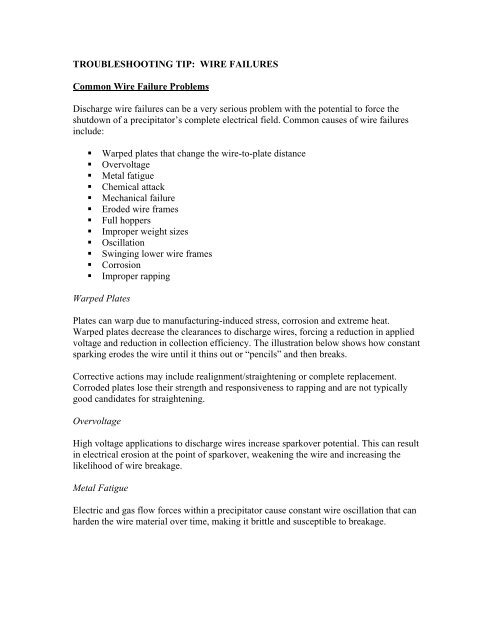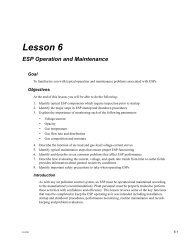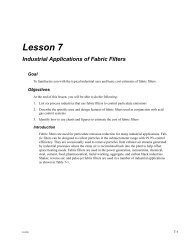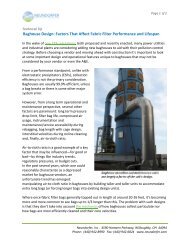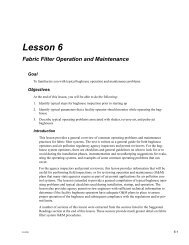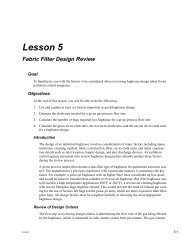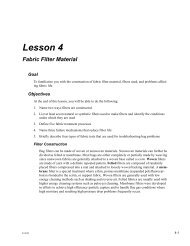Discharge Wire Failures
Discharge Wire Failures
Discharge Wire Failures
You also want an ePaper? Increase the reach of your titles
YUMPU automatically turns print PDFs into web optimized ePapers that Google loves.
Chemical Attack and Temperature InfluencesMany chemicals are corrosive and can contribute to wire failure. To maximize resistanceto failure, wire material composition should be selected as a function of the precipitatorenvironment and potential chemical exposure.Temperature also influences chemical activity. Temperatures that are too low can resultin damage to wires as the acid dew point is reached. In contrast, at high temperatures of600º or above, metal wires can elongate and result in wire slackening.Mechanical Failure<strong>Discharge</strong> wires can fail due to manufacturing defects in the wire material quality itself oras a result of improper attachment of hooks, buttons or shrouds. In addition, poorlydesigned attachment devices can contribute to spark erosion and wear.Eroded <strong>Wire</strong> FramesWorn wire frames fail to support wires by hooks or attachments because holes oropenings can elongate or enlarge and the wire is no longer held firmly in place. Electricalerosion can occur wherever there is a concentration of high electrical potential. Sharpedges on wire assembly parts, including shrouds, also contribute to wire frame erosion.Full HoppersThe collected particulate in full hoppers ultimately can push up the weights meant to keepwires taut, causing the wires to slacken or even short out.Improper Weight SizesWeights that are too light to keep wires taut allow increased oscillation which leads toincreased sparking.Oscillation<strong>Discharge</strong> wires oscillate in response to applied voltage as well as gas flow andineffective wire weights, resulting in the likelihood of wire failure over time.Swinging Lower <strong>Wire</strong> FramesLower wire frames are typically suspended from the upper frames. Gas flow and otherdisturbances can cause these lower frames to swing and reduce electrical clearances.
CorrosionMoisture is the most common corrosive in discharge electrode systems, contributing torusting of carbon steel wires. Acids can also be highly corrosive. To counteract manycorrosives, the use of chrome molybdenum alloys or stainless steel wires is required.Improper RappingImproper rapping can result in hardening of the electrode material, making wires brittleand more susceptible to failure.Failure AnalysisThe discharge electrode system should be examined whenever power is reduced in aprecipitator. If it is determined that the wires are failing or have failed, physicalinspection of the position occupied is necessary to determine if there are close clearancesthat could lead to spark erosion. Every effort should be made to document the wirelocation and time of failure using a precipitator plan view showing all wires by fieldlocation and position.If wire failures occur in groups served by one transformer-rectifier (T/R) set, closeclearances or swinging wire frames are the likely cause. Random wire failures can occurfor many of the reasons previously described.Should failed wires cause a short, the problem is serious and may require an entire fieldshutdown. Excessive failures provide sufficient reason for shutdown and internalinvestigation.Rules to Follow in a <strong>Wire</strong> Failure:• Keep a record of the failure date and location• Retain the failed wire for analysis• Provide an original, unused wire from the same source as the failed wire, forcomparative analysis• Identify the cause of the failure and take corrective actionCorrective Action for <strong>Wire</strong> <strong>Failures</strong>Corrective action for wire failures depends on the root cause. Multiple actions may berequired to prevent future failures. Failure analysis may involve a combination of on-siteinspection and physical analysis of the broken wire.Neundorfer has an experienced team of engineers to assist in the identification of wirefailures and the implementation of cost effective, practical solutions. Neundorfer alsomanufactures new discharge electrode wires. For more information about Neundorferwire products and services, call (440) 942-8990.


